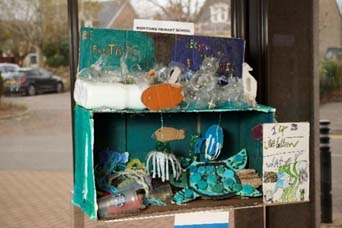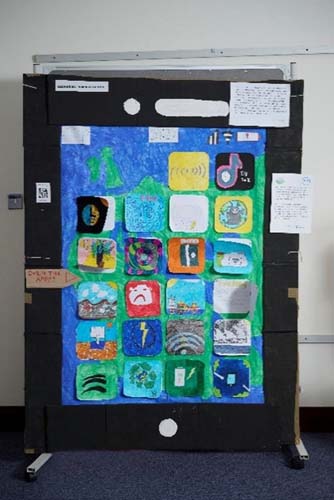2.1 Case study: Art for Action
This project, run by Highland One World Global Learning Centre (2022), invited primary schools to create art projects relating to the Sustainable Development Goals. Their artwork was displayed at the Highland Council headquarters for two weeks while COP27 was taking place in Sharm El-Sheikh, Egypt.
The project had three stages – Learn, Think, and Get Creative:
- Learn asked groups to identify a climate issue that mattered to them, using the SDGs and UNCRC as a starting point. Groups then researched the issue to find out more.
- Think then asked groups to identify the change they wanted to see (locally or globally) on this issue.
- Get Creative invited the groups to create a piece of eye-catching artwork to communicate the change they wanted to see, as well as make a very short video to introduce themselves and the piece.
The artwork was not only about co-producing something (in a sociological sense) but it also raised important questions about young people's ability and opportunity to participate in and with their local environments and communities (in a democratic sense). It raised questions around young people’s:
- assumptions about and relationships with their immediate environments
- understanding of connections between local and global issues
- ability and opportunity to influence local and national policymakers
- ability to inspire change through visual art and storytelling
- ability to use found and repurposed materials for positive ends
- role in their local community as change-makers.
The feedback from the primary schools who took part was overwhelmingly positive, with many schools talking about the sense of accomplishment and pride that pupils felt in producing the pieces of art (Table 1). The pupils felt connected and a part of their community, feeling that they had played an important role in inspiring change.
Table 1 Pieces of artwork
| This piece used recycled pieces of rubbish to create an underwater scene. The piece focuses on SDG 14 – Life below water and uses a catchy slogan to grab people’s attention – be fantastic, recycle your plastic! |
| This piece uses a repeating bottle shape to give voice to nature and underwater life that has been affected by human-caused climate change, and damage by plastics in the ocean. |
| This piece creates an eye-catching and interactive piece to explore issues relating to the environmental and human impact of the lifecycle of technology, particularly smart phones. |
Activity 3.1 Participation for community (people, environment, policy) benefit
Future-making through participation requires more than received knowledge and working towards pre-planned outcomes set by the educator. It requires a shift towards forward-thinking, imaginative, experimental, and playful approaches to pedagogy. This is discussed more in Unit 4: Transdisciplinarity, but below is an optional activity focused on the role of imagination and hope.
 Explore
Explore
Read Pheobe Tickell’s blog about Imagination Activism.
Consider how imagination features in your own practices? How does allowing imagination space in pedagogy promote a different type of participation?
- Imagination Activism – by Phoebe Tickell (substack.com)
2 For whose benefit? The case for participatory sustainable pedagogies



